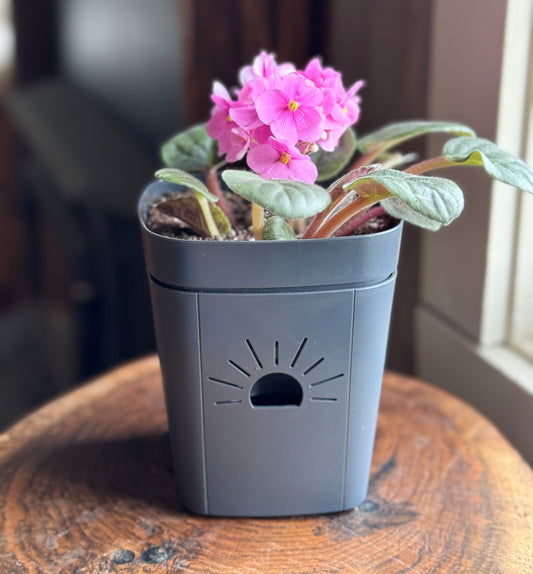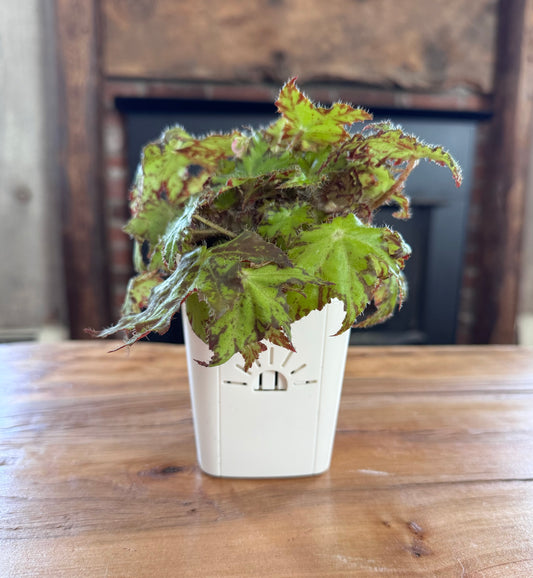Origins
Ficus is a genus of woody trees, vines, shrubs, and epiphytes, in the Moraceae (fig/mulberry) family. Also known as fig trees or figs, they are generally native to tropical climates, but some species can grow in semi-warm temperate regions, like the common fig (F. carica). Ficus is a pantropical genus, meaning it grows in many different ecological areas, mostly evergreen, but some deciduous species can be seen in non-tropical areas and at higher elevations. They are distinctively identified by their unique inflorescence and mode of pollination, which is done by wasps.
Light
Requirements
All of the ficus species commonly grown as houseplants prefer bright indirect light. They can adapt to lower light levels but will not thrive without plenty of sunlight.
In the northern hemisphere, an east or west window is ideal. You can put a Ficus in front of a south-facing window as long as it is 48 inches or more away from the glass. In very sunny southern climates, use a sheer curtain to filter the light.
Genus Summary
| GENUS | Ficus |
| COMMON NAMES | Weeping Fig, Indian Rubber plant, Ficus tree, Benjamin fig. |
| LIGHT | Bright indirect light |
| WATER SCHEDULE | 14 days |
| WATER REQUIREMENTS | Consistently moist, but not soggy |
| HUMIDITY | Medium to High, depending on species |
| TEMPERATURE | 60-85°F. Cannot tolerate above 90°F or below 40°F |
| FEEDING | 1x month |
| TOXICITY | Toxic to humans ad animals |
| PESTS | Aphids, mealybugs, and scale insects. If too dry, spider mites or thrips. |
| DISEASES | Phytophthora rot if the pot has little oxygen |
| POT | High airflow in the root zone is crucial |
| SOIL | Rich with excellent drainage. Equal parts sand, garden loam or potting soil, and peat moss. |
| FERTILIZER | Balanced liquid fertilizer 1x monthly during spring and summer |
| PROPAGATION | Either air layering or offsets, depending on species |
| PRUNING | Can prune into tree, shrub, or bonsai |
| SIZE | 8 inches to 20 feet tall indoors |
Water Requirements
You can follow a 14-day watering schedule using a Naked Root planter.
For those using a conventional planter pot, wait to wait until the top two inches of soil is dry.
When your ficus plant is in its active period of growth, keep the soil damp by giving it a deep watering. During the dormant season, make sure the soil is not overly arid, as it is possible to give too little water. Clean the leaves of your Ficus to enable it to take in the air better, but do not apply any kind of leaf shine. Additionally, mist the leaves occasionally to help prevent pests.
Humidity
Ficus plants are adaptable to most levels of humidity and thrive best with medium humidity levels. The average humidity found in the typical home is more than enough for a Ficus plant to be content. However, misting the leaves on occasion can provide additional benefits. This helps create an environment that spider mites and thrips find unpleasant, which deters them from settling on your Ficus plant.
If you want to ensure optimal health for your Ficus, you should mist its leaves every couple of days or when the air feels particularly dry. Additionally, if there is any sign of mildew or mold growth in particular areas, it’s important to address this issue immediately, as these organisms can cause significant damage over time if left unchecked.
Temperature
Ficus plants are relatively hardy and can thrive in a variety of conditions. However, they do not tolerate extreme hot or cold temperatures well. While the average household temperature of 60-85°F makes them comfortable and happy, anything below 40°F or above 90°F will cause rapid leaf loss as well as other symptoms such as wilting leaves, yellowing foliage, and stunted growth. If exposed to these extreme temperatures for too long, Ficus plants will eventually die. Therefore to ensure your Ficus plant is healthy and thriving, maintain an optimal temperature range between 60-85°F at all times.
Toxicity
Ficus plants are toxic to humans, cats, dogs, and other animals if ingested. The sap of Ficus plants contains several compounds that can cause skin irritation or gastrointestinal distress in both humans and pets. Symptoms may include rashes, vomiting, diarrhea, and excessive drooling. If you suspect your pet has eaten a part of your Ficus plant, contact your vet immediately, as the symptoms can be severe. Never let children play with Ficus plants, as they are not aware of the potential danger of ingesting them. To prevent any accidents from occurring, keep these plants out of reach from curious hands or paws!
Pests and Diseases
Be on the lookout for aphids, scale insects, and mealy bugs if you have a Ficus in your home. If you find any, try using an organic liquid insecticide or horticultural soap to remove them. Taking action soon will help prevent them from taking over your plant. As long as you provide adequate humidity, you will likely not see spider mites or thrips.
Ficus houseplants are generally not prone to many diseases. However, overwatering can make them more susceptible to issues like Phytophthora, which causes root and crown rot. To prevent this, make sure not to give your plant too much water and provide maximum root zone aeration. The only other issue they can suffer from is nematodes, which is rare.
Pot
When selecting a pot for your Ficus plant, consider the potential risks of Phytophthora root rot. The best type of pot will have plenty of breathing room around the roots – this allows oxygen to flow freely and stimulates hundreds of new root hairs on the plant. These feeder roots help ensure that the Ficus has access to enough water and nutrients to stay healthy and prevent leaf drop or other diseases.
Soil
Ficus plants are very particular when it comes to soil conditions. They need soil that is rich and loamy with excellent drainage in order to thrive. The ideal mixture for Ficus plant care is equal parts sand, garden loam or potting soil, and peat moss. This combination will ensure that the roots don’t remain waterlogged but also retain enough moisture, so they aren’t too dry either.
Fertilizer
When fertilizing your Ficus plant, use a balanced (8-8-8 or 10-10-10) liquid fertilizer diluted to half strength. Feeding should be done once per month in the spring and summer months when the plant is actively growing. In the fall and winter months, it’s important not to apply any fertilizer, as this can be detrimental to the health of your Ficus when it enters its dormant period.
Propagation
The easiest way to propagate a Ficus plant is with air layering. Find a vigorous and healthy leaf. Cut halfway through the stem and dab it with rooting hormone. Wrap wet sphagnum peat moss around the cut and cover that loosely with plastic. After a few weeks, you will see roots growing into the moss, and you can cut your baby ficus loose from the parent plant.
Once you have your baby Ficus, you can plant it in a container filled with soil. Position the plant so that its roots are covered below the surface of the soil and lightly tamp down on top. Water regularly until established, then follow the same schedule as the parent plant. Place your new Ficus in an area with indirect light and give it some space from other plants for air circulation.
Pruning
Pruning is not necessary, but you can prune Ficus plants to grow in particular shapes. Some people prefer them to grow in a tree shape and remove the lower branches, for example.
Trim the thinner sections of the branches, making sure to cut directly above the leaf nodes. Doing so will help maintain the size of the plant and will cause new branches to sprout up. Make sure you leave at least one set of leaves so the plant can continue to photosynthesize and regenerate.
10 Striking Varieties and Cultivars
For centuries, Ficus plants have been a popular choice for decorating people’s homes. From the more traditional fiddle leaf fig to the less common triangle ficus, this genus of plants provides a wide range of interesting species. Although they may be a bit finicky about their environment, if you manage to get it right, these plants can thrive for years and bring plenty of lush growth as well as clean air into your home.
Fiddle Leaf Fig – Ficus lyrata is the plant that everyone thinks of when they hear the word Ficus. It is the most popular indoor focus for a good reason. It has a beautiful brown trunk and wide shiny leaves that do look somewhat like fiddles. The leaves are broader at the bottom than at the top and are deeply veined. Outdoors, in their native home of Africa, a fiddle leaf can grow up to 60 feet tall! Indoors they are fast growers and can reach 10 feet tall in only a few years. They like humidity between 30-60 percent and evenly moist soil.
Creeping Fig – Ficus pumila is a climbing variety of Ficus that originates in east Asia. It grows thin, delicate vines covered in bright green leaves trimmed in white. It is self-clinging and will happily grow up a moss pole or along the walls of your rooms. It also looks lovely cascading over the edge of a hanging pot. This Ficus easiest one of the easiest to grow and thrives in 50 percent humidity levels or higher.
African Fig Tree – Ficus cyathistipula is a tree Ficus or shrub, depending on how you prune them. It grows natively in a tropical forest in Africa and has shiny, oval leaves that are elongated. The African Fig, with its striking glossy dark green leaves, is a lovely addition to any home. It is easy to take care of and can tolerate typical indoor living conditions. This particular fig is known for its branching growth pattern and its flaking bark, which is reminiscent of birch bark. It is particularly sensitive to sunburn, so do not place it in front of direct light or southern windows.
Mistletoe Fig – Ficus deltoided is an evergreen shrub or small tree that is native to Southeast Asia but is often grown indoors as a houseplant. It has shiny, waxy green leaves with yellow undersides and triangular black glands between the veins. This species produces yellowish, inedible figs throughout the year and can also be used as a bonsai specimen. It prefers medium to high light, drier soil, and medium humidity with temperatures over 55 degrees Fahrenheit. It can tolerate low light and may survive short periods of cold weather down to 30 degrees F. Lastly, it is easy to prune and rarely has pest or disease issues. This Ficus grows about three feet tall indoors.
Burgundy Rubber Tree – Ficus elastica ‘Burgundy’ is one of the most beautiful Ficus plants that you can grow indoors. It is famous for its thick, glossy leaves that grow up to 12 inches long and 5 inches wide. The base of the leaf stalk is pink and purple and stands out against the green. It grows aerial roots along the trunk. It is native to the rainforests of South America and Inda, and as you can imagine, it likes humidity in the 65-80 percent range. A humidifier is a good idea with this Ficus. If happy, it will require very little maintenance and grow 13 feet tall indoors!
Weeping Fig – Originating in India and spreading throughout northern Australia, Ficus benjamina is a beautiful evergreen tree that can grow up to 50 feet tall outdoors. It is typically seen in tropical climates as either a decorative tree or hedge. This species has become extremely popular for growing indoors due to its pleasing shape and ability to thrive in diverse conditions. Indoor plants usually reach between two and ten feet in height. The trunk of Ficus benjamin has a pale brown hue with a thick canopy of foliage, and it is sometimes braided for a more ornamental look. The leaves are glossy and oval-shaped, reaching up to four inches long. Additionally, the branches of this tree are known for their graceful arching. Its stems also contain milky sap, though it rarely fruits or flowers when grown indoors.
Banana Leaf Ficus – Ficus binnendiijkii’ Alii’ is a gorgeous indoor houseplant with strappy bamboo-like leaves. It is often sold with a braided trunk and grown into a bonsai or tree shape. The leaves are olive green and require very little care. This ficus tree grows 6-8 feet tall indoors and needs 60-80 percent humidity.
Ficus Ginseng – Ficus microcarpa has quite a few common names. It is called Laurel Fig, Indian Laurel, Chinese Banyan, Strangling Fig, and Curtain Figh, among others. It is famous for its thick trunk and large aerial roots that grow above the soil. It is an excellent bonsai tree with dark green leaves that are shiny and ovular. In tropical climates, it will grow 60 feet tall and wide outdoors. Inside, you can expect it to reach five feet tall. It is very easy to propagate because the aerial roots will send up offsets that you can snip off and plant separately.
Ficus Audrey – Ficus benghalensis Audrey is also called Banyan Tree and is the national tree of India. In its native home, it grows 98 feet tall. Indoors it will reach 6-10 feet tall. It is a unique woody Ficus with a white trunk, aerial roots, and paddle-shaped leaves. The leaves are dark green on top and lighter on the underside with lime-green veins. This variety is not tolerant of low light and can actually benefit from 1 or 2 hours of direct sunlight per day.
Curly Creeping Ficus – Ficus pumila ‘Curly’ is a fun variety of Ficus to grow. It has wavy leaves that are green with lime and chartreuse stripes. It is a vining variety, and each stem can grow up to 8 feet long. It is a vigorous climber and will peel the paint from your walls if you pull it off. This is an easy variation that isn’t particular about humidity. It thrives in average household humidity levels of 50 percent.
Summary of Ficus Plant Care
Ficus is a long-lived houseplant grown for its gorgeous leaves. They require high humidity, warm temperatures, and evenly moist soil. Keep them in bright indirect light, mist regularly, and feed once per month during the growing season. You can leave them unpruned or prune them into a tree or bonsai shape as you desire.





 Verified Buyer
Verified Buyer









